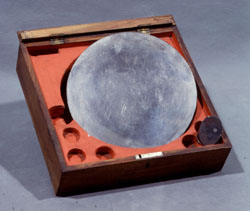 46. Herschelian telescope by G.B. Amici
46. Herschelian telescope by G.B. Amici
Modena, 1813
Giovan Battista Amici (Modena 1786 - Florence 1863)
walnut, brass, wooden frame
length of tube 280 cm, diameter 23 cm
focal length 266 cm, diameter primary mirror 17 cm
[Inv. MdS-9]
The telescope is described in Ceschi’s inventory as follows: "Herschelian telescope built in Modena by Professor G.B. Amici in 1813, consisting of a wooden tube with walnut veneer 7 feet long (266 cm), at the end of which supported by an iron frame sits a metal mirror 5 and ½ inches (17 cm) in diameter. At the eye-piece end there is a small mirror inclined at 45°. A small guide telescope is attached to the outside of the tube, the optical axis of which can be moved and made parallel to the axis of the telescope. This instrument is supported by a guillotine mount that slides on four metal runners, but which can also be locked by three screws in its foot. Attached to the frame are various devices to allow the telescope to be pointed in any direction, even when small movements are involved.
The telescope is fitted with:
- No. 6 eye-pieces of different magnifications.
- A metal tube, that screws to the eyepiece holder, allows the eye-pieces of the parallactic telescope
[by Dollond] to be used.
Two metal covers to protect the two mirrors (still extant).
The eye-pieces of the telescope are still kept in a drawer [Inv. MdS-91] attached to the frame in which are also kept the eye-pieces of the parallactic and other telescopes."
This type of telescope is named after Friedrich Wilhelm Herschel (Hannover 1738 - Slough 1822), who designed numerous telescopes on the Newtonian model - metal parabolic primary mirror, secondary mirror inclined at 45° - arriving at primary mirrors with diameters of one metre and a half and focal lengths more than twelve metres. It was with instruments of this kind that Herschel discovered the planet Uranus in 1781.
The Modenese Amici, optical craftsman, astronomer and botanist, was also engineer, architect and professor of geometry and algebra. Such was his fame as optical instrument maker the Duke of Modena, in 1825, relieved him of his teaching duties so he could devote his time exclusively to instrumental optics. In 1831 he was appointed director of the Astronomical Observatory and the Museum of Physics and Natural History in Florence, and was awarded the chair in Astronomy at the University of Pisa. He built some excellent achromatic lenses for telescopes and dioptric microscopes, invented the immersion objective for microscopes, the roof prism and the direct vision dispersion prism, which was named after him. He was also a successful dealer with his own products.
Amici’s laboratory Notebook begins in 1822 and so the Bologna telescope is not mentioned. At the beginning of his work - the period our instrument dates from - his attention was focused above all on mirrors; in fact, the telescopes he sent to Milan did not have support frames. This fact would seem to suggest that the guillotine mount [Inv. MdS-65] of the Bolognese instrument was not built by Amici in person, even if cited in the 1843 inventory mentioned above.
A. Mandrino, G. Tagliaferri, P. Tucci (1989).
 46. Herschelian telescope by G.B. Amici
46. Herschelian telescope by G.B. Amici